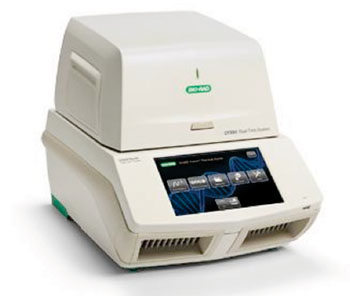Multiplex Assay Identifies Diarrheagenic Escherichia coli
By LabMedica International staff writers
Posted on 14 Aug 2014
A rapid, reliable and repeatable method is urgently needed for identifying diarrheagenic Escherichia coli (DEC) so as to provide the reference for responding to diarrheal disease outbreaks and the treatment of the diarrheal patients associated with DEC.Posted on 14 Aug 2014
A multiplex real-time polymerase chain reaction (PCR) assay based multicolor-combinational probe coding (MCPC) for the identification of eight foodborne pathogens has been developed and applied to the rapid diagnosis of a foodborne disease outbreak successfully.

Image: The CFX 96 Touch Real-Time Polymerase Chain Reaction (PCR) System (Photo courtesy of Bio-Rad).
Molecular biologists at the Xiamen University (China) designed specific primers and modified molecular beacon probes of nine specific virulence genes, whose 5′ end were added with homo tail sequence. They developed and optimized a two-tube modified molecular beacon based multiplex real-time PCR (rtPCR) assay for the identification of five Escherichia coli pathotypes.
A total of 102 bacterial strains, including 52 reference bacterial strains and 50 clinical strains, were isolated to confirm whether the target genes selected were specific. The detection limits of the assay were then tested. Lastly, the assay was applied to the detection of 11,860 clinical samples to evaluate the specificity and sensitivity of the developed assay compared with the conventional PCR. Multiplex rtPCR reactions were performed on the Bio-Rad CFX 96 Real-Time PCR System (Bio-Rad; Hercules, CA, USA).
The target genes were 100% specific as assessed on 102 bacterial strains since no cross-reactions were observed. The detection limits ranged from 88 colony forming units (CFU)/mL for Enterohemolysin E. coli (EHEC) to 880 CFU/mL Enteropathogenic E. coli (EPEC). Compared with the conventional PCR, the specificity and sensitivity of the multiplex rtPCR was 100% and over 99%, respectively. The coefficient of variation (CV) for each target gene ranged from 0.45% to 1.53%. Of the 171 positive clinical samples, 111 (64.9%) were identified as Enterotoxigenic E. coli (ETEC) and 38 (22.2%) as Enteropathogenic E. coli which were the dominating pathotypes of DEC strains.
The authors concluded that they had developed a rapid and effective two-tube multiplex rtPCR for the identification of all DEC pathotypes. This method took only 90 minutes and saved resources including biochemical reagents, disposable medical supplies and could be used in clinical and public health laboratories. The study was published on July 15, 2014, in the journal Annals of Clinical Microbiology and Antimicrobials.
Related Links:
Xiamen University
Bio-Rad














